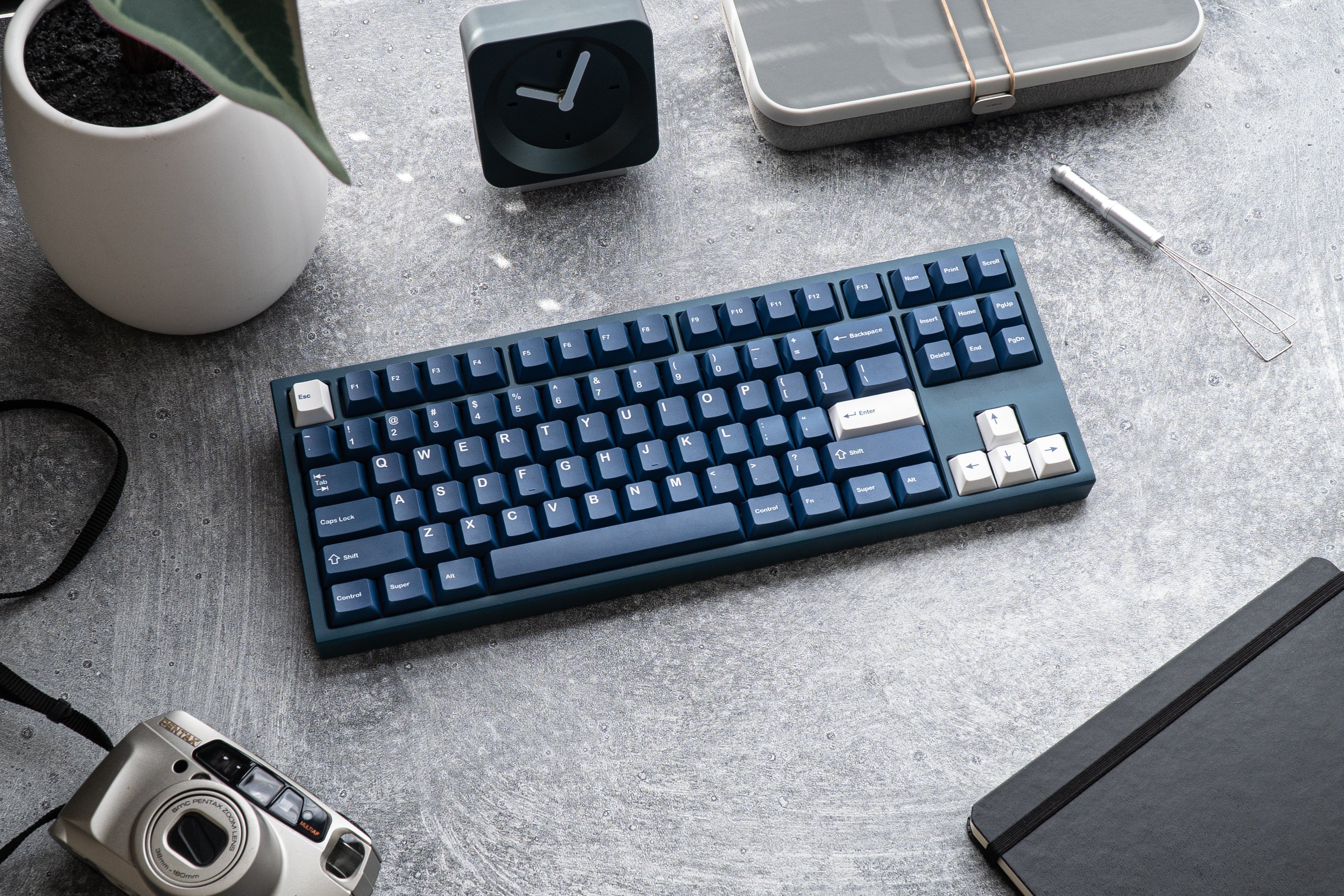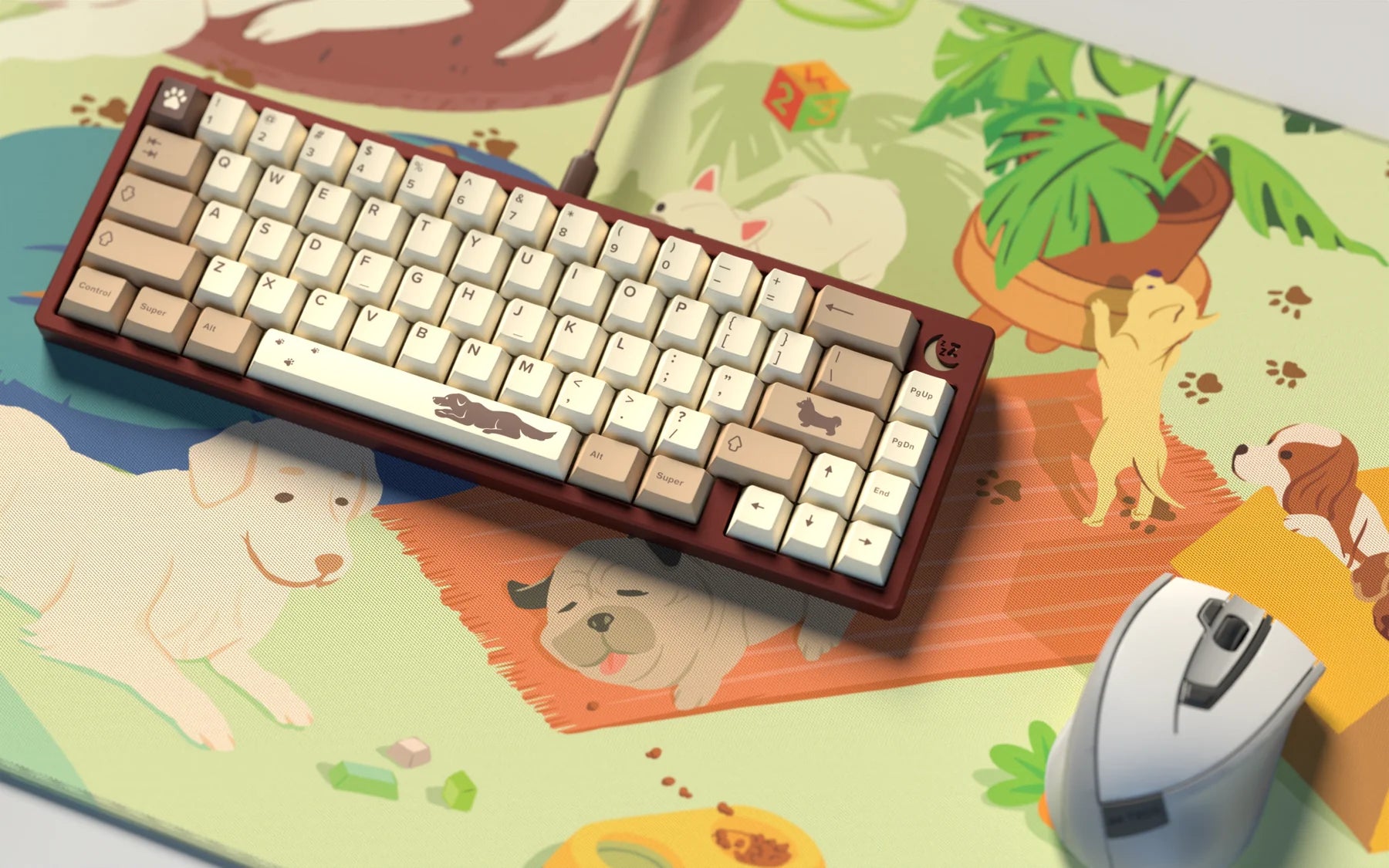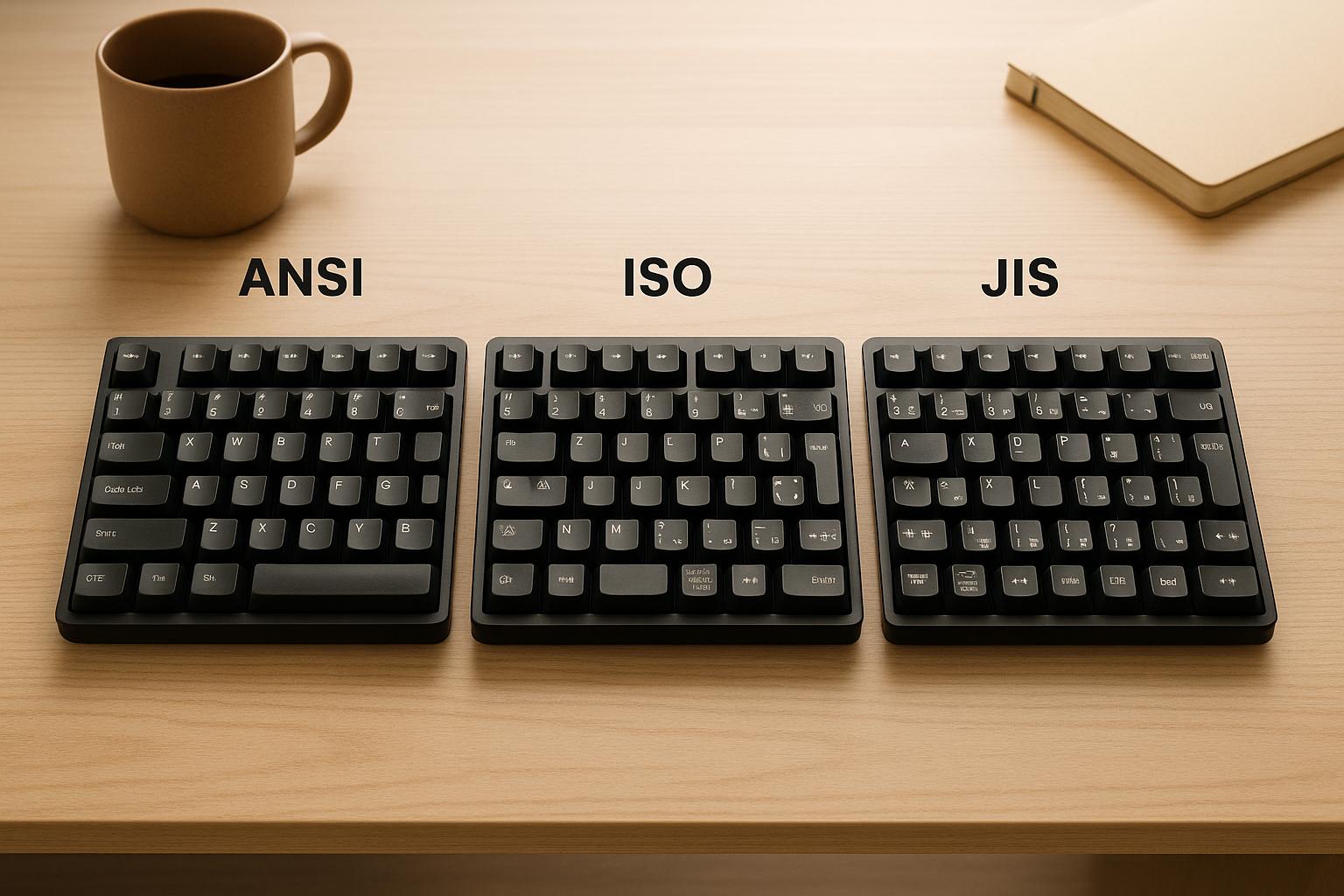When deciding between a metal or plastic keyboard case, the choice affects weight, durability, typing feel, and overall experience. Here's a quick breakdown:
-
Metal cases (e.g., CNC-machined aluminum):
- Sturdy and durable, built to last.
- Heavier (2–5 lbs), offering stability during use.
- Crisp typing feel with more pronounced sound.
- Sleek finishes, often anodized for long-lasting color.
-
Plastic cases:
- Lightweight and portable (around 2 lbs or less).
- More affordable but less durable.
- Softer typing feel with quieter keystrokes.
- Available in a variety of colors and designs for personalization.
Key takeaway:
Choose metal for a durable, stable, and premium feel, ideal for stationary setups. Opt for plastic if portability and budget are priorities.
Quick Comparison
| Feature | Metal Cases | Plastic Cases |
|---|---|---|
| Weight | Heavy (2.03–4.9 lbs) | Lightweight (around 2 lbs) |
| Durability | Long-lasting, resists wear | Less durable, prone to damage |
| Typing Feel | Firm, responsive, louder sound | Softer, quieter |
| Price | Higher ($160–$250 for full kits) | Budget-friendly |
| Portability | Better for stationary setups | Easy to carry |
| Customization | Sleek anodized finishes, refined | Wide variety of bold designs |
Your choice depends on your typing preferences, usage, and budget.
Aluminum VS Plastic Case | Which mechanical keyboard is the right one for you?
Weight and Portability
The weight of your keyboard case plays a big role in how it performs and fits into your daily routine. Whether you're looking for something sturdy or easy to carry, the material - metal or plastic - makes all the difference.
Metal Cases: Heavy and Steady
Metal cases, particularly those made from CNC-machined aluminum, bring noticeable weight to your keyboard. This extra heft isn’t just for show - it ensures your keyboard stays firmly in place while typing. For example, keyboards in the Freebird collection weigh between 2.03 and 4.9 pounds, making them a solid choice for those who value stability.
Plastic Cases: Lightweight and Portable
On the other hand, plastic cases are much lighter, which makes them perfect for users who need portability. Weighing around 2.2 pounds (about 1 kg) or less, these cases are easy to grab and go, whether you're switching desks or packing for a trip.
Balancing Stability and Mobility
Choosing between metal and plastic comes down to how and where you use your keyboard. If your setup is stationary, a heavier metal case provides the stability you need. But if your keyboard travels with you, a lighter plastic case is a more practical option.
Durability and Lifespan
When choosing a custom keyboard, understanding how long the case will last is essential - both for performance and cost. The material of the case significantly impacts its durability and overall lifespan. Let’s take a closer look at how metal and plastic cases measure up over time.
Metal Cases: Built to Last
Metal keyboard cases, especially those made from CNC-machined aluminum, are known for their exceptional durability. Take the Freebird Collection by KeebsForAll, for example. Featuring 60%, 75%, and TKL layouts, these keyboards showcase the strength and reliability of premium materials. Metal cases can endure heavy use while maintaining their structural integrity, making them a solid choice for longevity.
Plastic Cases: Budget-Friendly, Less Sturdy
Plastic cases are a more affordable option but tend to be less durable. They are more susceptible to cracking or warping under pressure. While high-quality plastics can hold up well under normal use, they often struggle to maintain their appearance and structure as effectively as metal cases in tougher conditions.
Keeping Your Keyboard in Great Shape
To make your keyboard last longer, proper maintenance is key. For metal cases, use a damp microfiber cloth to gently clean the surface. For plastic cases, mild soap and water work well - just steer clear of abrasive cleaners. Regular care and careful handling can help keep your keyboard looking and performing at its best.
Typing Feel and Sound
The material of your keyboard case plays a big role in shaping both how it feels to type and the kind of sound your keystrokes produce.
Metal Cases: Firm and Responsive
Metal cases provide a solid, rigid base that many typists appreciate. Their lack of flex gives keystrokes a crisp, responsive feel, making each press feel precise. Plus, the density of metal often creates a more pronounced sound profile, which some users find satisfying.
Plastic Cases: Softer and Quieter
Plastic cases, on the other hand, offer more flexibility. This added give can create a softer, cushioned typing experience that’s especially comfortable for long sessions. Plastic also absorbs vibrations better, which often results in a quieter typing sound - ideal for those who prefer a more subdued auditory experience.
How Material Shapes Tactile Feedback
The material of your keyboard case doesn’t just affect sound - it also impacts how you experience the tactile feedback of your switches. A metal case tends to enhance the distinctness of each keypress, making the feedback feel sharper and more defined. In contrast, the flexibility of plastic can mellow this sensation, creating a softer, less pronounced response.
Ultimately, whether you lean toward the sharp, responsive feel of metal or the softer, quieter vibe of plastic will come down to your personal typing preferences and where you’ll be using your keyboard. Next, we’ll dive into how these materials influence the keyboard’s look and customization potential.
sbb-itb-3cb9615
Looks and Customization
The material of your keyboard case not only impacts its weight and durability but also plays a big role in its overall appearance and how much you can personalize it. Metal and plastic cases each bring their own unique style to the table.
Metal Cases: Sleek and Sophisticated
Metal cases exude a polished, professional vibe with their durable and vibrant finishes. Take KeebsForAll's Freebird Collection, for example - it showcases the refined beauty of premium aluminum, available in shades like E-White, Navy, Olive (anodized), and Black. The anodization process ensures these finishes stay rich and evenly colored over time, making them long-lasting and visually appealing.
With their precise finishes and anodized coatings, metal cases fit right into office setups or minimalist designs. Options like Dark Green, Blue, and Lilac add a touch of understated elegance while keeping things clean and simple.
Plastic Cases: Bold and Creative
Plastic cases, on the other hand, open up a world of possibilities when it comes to design and color. Thanks to the flexibility of the material, manufacturers can create a wide range of hues and finishes, perfect for users who want their keyboard to stand out. Many enthusiasts love the creative freedom plastic cases provide, making them a go-to choice for those who prioritize a more personalized aesthetic.
Customization and Compatibility
No matter which material you choose, both metal and plastic cases are compatible with custom components. KeebsForAll makes it easy to experiment with their KFA PBT keycaps, KFA switches, and KFA deskmats. Plus, their hot-swappable Freebird series lets you effortlessly swap out switches and keycaps, giving you the freedom to fine-tune your setup to your liking, regardless of the case material.
Metal vs Plastic Comparison Table
Complete Comparison Chart
Here’s a breakdown of how metal and plastic keyboard cases stack up across key features:
| Feature | Metal Cases | Plastic Cases |
|---|---|---|
| Weight (lbs) | Heavy: 2.03–4.9 lbs depending on size | Lightweight |
| Durability | Built with premium aluminum for long-lasting durability | Affordable but less durable |
| Price | Example: Freebird60 priced at $75.00 | Budget-friendly option |
| Stability | Heavier build ensures a stable typing experience | Lighter weight means less stability |
| Customization | Supports hot-swaps and custom keycaps | Works with custom components |
Note: Specific details about plastic cases were not fully provided by the sources cited.
This table underscores the advantages of metal keyboard cases, such as their durability, stability, and customization potential. For example, metal cases like the Freebird series from KeebsForAll stand out for their solid construction and user-friendly features. On the other hand, plastic cases may appeal to those seeking a lightweight, budget-conscious option, though their performance and durability can vary. If you lean toward plastic, you might want to explore additional details to find the right fit for your setup.
Which Case Material Should You Choose?
Deciding between metal and plastic keyboard cases comes down to your workspace setup, budget, and personal preferences. Here’s a quick recap to help you make the right choice.
Go for metal cases if you have a fixed desk setup and appreciate a sturdy, high-quality build. The weight of a metal case, like the 4.9-pound Freebird TKL aluminum case, ensures it stays firmly in place during intense use. Plus, metal cases offer great value for their durability, with full metal keyboard kits priced between $160.00 and $249.99, making them a solid long-term investment.
Opt for plastic cases if portability is your top priority. Their lighter weight makes them ideal for users who need a keyboard that’s easy to carry around.
If your setup is stationary and you’re looking for something durable with a premium typing feel, an aluminum case like the Freebird series is an excellent option, as highlighted in the comparisons above.
FAQs
How can I maintain and extend the lifespan of metal and plastic keyboard cases?
Keeping your keyboard case in good shape takes a little regular care. Here’s how to handle it based on the material:
For metal cases, use a soft, damp cloth to gently clean away dust and smudges. Steer clear of harsh chemicals - they can mess up the finish. To avoid scratches, consider using a desk mat and be extra cautious when assembling or taking apart your keyboard.
If you’ve got a plastic case, a quick wipe with a microfiber cloth will take care of dirt and fingerprints. Watch out for direct sunlight, as it can lead to discoloration or even warping over time. Also, keep your keyboard away from extreme temperatures - too much heat or cold can mess with its structure.
With these easy steps, you can keep your keyboard case - whether metal or plastic - looking great and holding up well for the long haul.
How do metal and plastic keyboard cases impact the typing feel?
The material of your keyboard case can greatly influence how it feels to type. Metal cases, like those made from aluminum, often deliver a sturdy, high-end feel. They also tend to create a firmer and slightly louder typing experience because of their rigidity and weight.
In contrast, plastic cases are much lighter and can provide a softer, more cushioned feel. This can make them a popular choice for people who spend long hours typing and prioritize comfort.
Choosing between metal and plastic really depends on what matters most to you. If you're after durability and a sleek, premium look, a metal case might be the way to go. But if you value a lightweight design and a quieter, more forgiving typing experience, a plastic case could suit you better.
Can you use different keycaps and switches with metal or plastic keyboard cases?
Yes, you can mix and match keycaps and switches with both metal and plastic keyboard cases, as long as the components are compatible with your keyboard's layout and switch type. Compatibility depends on factors like the switch mounting style (e.g., plate-mounted or PCB-mounted) and the keycap stem type (e.g., Cherry MX-style).
Both metal and plastic cases work with a wide range of keycaps and switches, so the material of the case won’t restrict your customization options. That said, the case material does influence the overall feel and sound of your keyboard. For instance, metal cases often provide a sturdier, more solid typing experience, while plastic cases can offer a lighter, softer sound profile. When building your ideal keyboard, consider how these elements come together. If you’re in search of quality keyboard parts, KeebsForAll has a wide selection to explore.



![[Pre-Order] Autumn Leaves PBT Keycaps - KeebsForAll](http://keebsforall.com/cdn/shop/products/DSC09732.jpg?v=1676148273)





Leave a comment
This site is protected by hCaptcha and the hCaptcha Privacy Policy and Terms of Service apply.